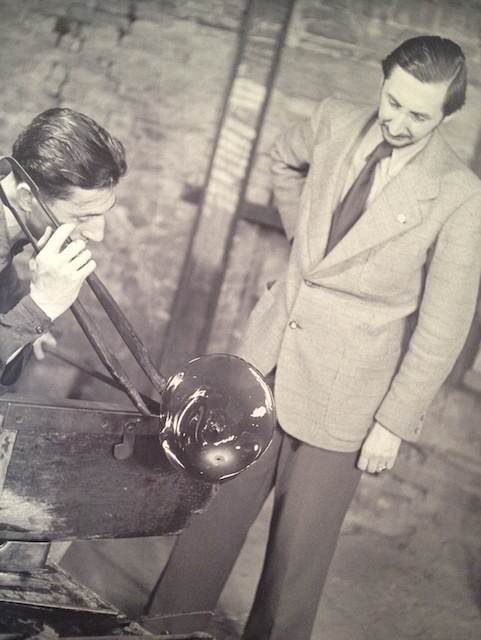CARLO SCARPA
CARLO SCARPA

[vc_row][vc_column][vc_single_image image=”3677″ img_size=”full”][/vc_column][/vc_row][vc_row][vc_column][vc_empty_space height=”50px”][vc_column_text]Carlo Scarpa – Venini 1932-1947
Le Stanze del Vetro
San Giorgio Maggiore
Venice
(free)
photos: nathalie hambro
The exhibition Carlo Scarpa. Venini 1932–1947 curated by Marino Barovier reconstructs Carlo Scarpa’s creative development as artistic director of the Venini Glassworks from 1932 to 1947. Due to run until 29th November 2012, the exhibition is organized around a selection of over 300 works. Some works are shown for the first time and many are from major international public and private collections.
The works are divided into approximately thirty types that vary according to execution techniques and glass textures. The material on show also includes prototypes, one of a kind, original drawings and designs, plus period photographs and archive documents. The exhibition explores the significance and importance of Carlo Scarpa’s glass designs in his overall work. During his Murano period, Scarpa further developed his interests in experimentation and craftsmanship and the show thus provides a unique opportunity to compare his work as a glass and furniture designer and his architecture.
In 1932 Carlo Scarpa began working with the Venini glassworks. He was to design some remarkable glass items for the company until 1947. His work involved continuous research into the materials, colours and techniques, which he adopted in a personal way to reinterpret old traditions and, together with the master glassblowers, to invent new working procedures.
In the early years he designed series of glass items called a bollicine (bubbles), a mezza filigrana (half-filigree), and sommersi (overlaid); the latter series was shown at the Venice Biennale in 1934. In the Biennale and the 6th Milan Triennial in 1936 some elegant lattimi (milk-white) and murrine romane (‘Roman’ murrines), created in collaboration with Paolo Venini, were shown with some typically rough corrosi (acid-etched) works.
At the 1938 Biennale, Scarpa diversified his exhibited pieces by showing both vases and everyday objects. Meanwhile the Venini showroom displayed objects described as beinga puntini (dotted), a fasce (with bands) and rigati (striped). They paved the way to the colourful tessuto (woven) series shown at the next Biennale.
1940 was a significant year for the Murano glassworks: at the Milan and Venice exhibitions the company showed a representative collection of glass objects designed by Scarpa. Some only had a limited production, both because of technical difficulties and of high costs. This was the case with the works called laccati neri e rossi (black and red lacquered), granulari (granulated) and incisi (incised). Other types, however, such as the cinesi (Chinese), which echoed forms of Eastern porcelain, or the battuti (hand-ground) and tessuto (woven) series, were to be produced in larger numbers. Of the 1940 works, the series of murrine opache (opaque murrines) with their milled, polished surface stood out for their refined textures. The 1942 Biennale was the last Scarpa took part in as a glass designer. After the Second World War, Carlo Scarpa ended his collaboration with Venini to become a full-time architect.*
* read: Negozio Olivetti
LE STANZE DEL VETRO is a long term joint initiative between Fondazione Giorgio Cini and Pentagram Stiftung devoted to studying the art of glassmaking in the twentieth and twenty-first centuries.
The project marks the opening of a new permanent exhibition space designed to host a series of solo and group shows featuring international artists, both contemporary and historical, who have used glass during their careers as an orginal means of expression and medium for researching their own personal aesthetics. The aim is to illustrate the numerous potential uses of the medium and put glass back at the centre of attention and discussion on the international art scene. The venue is the West wing of the ex-Convitto (a former boarding school) on the Island of San Giorgio Maggiore. With 650 square metres of exhibition space, the exhibition centre will not only host exhibitions but also conferences, workshops and other events dedicated to glass.
Link: Yali Murano Glass design[/vc_column_text][/vc_column][/vc_row][vc_row][vc_column][vc_empty_space height=”50px”][vc_single_image image=”3678″ img_size=”full”][vc_empty_space height=”50px”][vc_single_image image=”3679″ img_size=”full”][vc_empty_space height=”50px”][vc_single_image image=”3680″ img_size=”full”][vc_empty_space height=”50px”][vc_single_image image=”3681″ img_size=”full”][vc_empty_space height=”50px”][vc_single_image image=”3682″ img_size=”full”][vc_empty_space height=”50px”][vc_single_image image=”3683″ img_size=”full”][vc_empty_space height=”50px”][vc_single_image image=”3684″ img_size=”full”][vc_empty_space height=”50px”][vc_single_image image=”3685″ img_size=”full”][vc_empty_space height=”50px”][vc_single_image image=”3686″ img_size=”full”][vc_empty_space height=”50px”][vc_single_image image=”3688″ img_size=”full”][vc_empty_space height=”50px”][vc_single_image image=”3687″ img_size=”full”][vc_empty_space height=”50px”][vc_single_image image=”3689″ img_size=”full”][vc_empty_space height=”50px”][vc_single_image image=”3690″ img_size=”full”][vc_empty_space height=”50px”][vc_single_image image=”3691″ img_size=”full”][vc_empty_space height=”50px”][vc_single_image image=”3692″ img_size=”full”][vc_empty_space height=”50px”][vc_single_image image=”3693″ img_size=”full”][vc_empty_space height=”50px”][vc_single_image image=”3694″ img_size=”full”][vc_empty_space height=”50px”][vc_single_image image=”3696″ img_size=”full”][vc_empty_space height=”50px”][/vc_column][/vc_row][vc_row][vc_column][vc_column_text css_animation=”none” el_class=”with-link”]![]() back to ART DIARY[/vc_column_text][/vc_column][/vc_row]
back to ART DIARY[/vc_column_text][/vc_column][/vc_row]

Comments are closed.